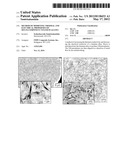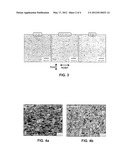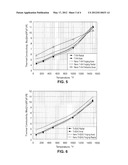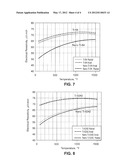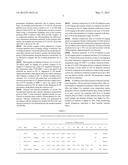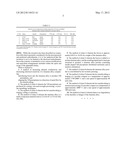Patent application title: Method of modifying thermal and electrical properties of multi-component titanium alloys
Inventors:
Seshacharyulu Tamirisakandala (Beavercreek, OH, US)
Assignees:
FMW Composite Systems, Inc.
IPC8 Class: AC22F118FI
USPC Class:
148 95
Class name: Metal treatment process of modifying or maintaining internal physical structure (i.e., microstructure) or chemical properties of metal, process of reactive coating of metal and process of chemical-heat removing (e.g., flame-cutting, etc.) or burning of metal
Publication date: 2012-05-17
Patent application number: 20120118433
Abstract:
A method of increasing the thermal conductivity and decreasing the
electrical resistivity of a titanium alloy. Boron is introduced into the
titanium alloy to produce TiB precipitates. The TiB precipitates are then
aligned in a direction of metal flow by hot metalworking.Claims:
1. A method of increasing thermal conductivity and decreasing electrical
resistivity of a titanium alloy comprising: introducing boron into the
titanium alloy to produce TiB precipitates, and aligning the TiB
precipitates in a direction of metal flow by hot metalworking.
2. The method of claim 1 wherein the TiB precipitates are produced by casting, cast-and-wrought processing, or powder metallurgy techniques.
3. The method of claim 1 wherein the hot metalworking is forging, rolling or extrusion.
4. The method of claim 1 wherein the titanium alloy is a multi-component material such as Ti-6Al-4V or Ti-6Al-2Sn-4Zr-2Mo.
5. The method of claim 1 wherein the boron is approximately 0.01% to 18.4% by weight of the titanium alloy.
6. The method of claim 1 wherein the boron is added to a molten titanium alloy, and the resulting liquid melt is inert gas atomized to produce a titanium alloy powder containing needle shaped TiB precipitates distributed uniformly and in random orientations.
7. The method of claim 6 wherein the titanium alloy powder is consolidated by hot isostatic pressing.
8. The method of claim 3 wherein the hot metalworking is forging of a powder compact at a temperature of approximately 1750-2000.degree. F. and a ram speed of approximately 40 inch./min.
9. The method of claim 3 wherein the hot metalworking is extrusion processing of a powder compact at a temperature of approximately 2000.degree. F. and a ram speed of approximately 100 inch./min.
10. The method of claim 1 wherein there is no degradation of the ductility or fatigue of the titanium alloy.
Description:
BACKGROUND OF THE INVENTION
[0001] 1. Field of the Invention
[0002] The present invention relates to a method of improving physical properties of titanium alloys and, more specifically, a method of increasing thermal conductivity and reducing electrical resistivity of articles made of titanium-based compositions.
[0003] 2. Description of the Background Art
[0004] Titanium alloys offer attractive physical and mechanical property combinations that provide significant weight savings in various industries such as aerospace and space. Thermal conductivity of titanium alloys, however, is low compared to other structural metals such as steel and aluminum. Low thermal conductivity of titanium alloys affects heating rates and obtainable cooling rates after processing and heat treatments. Another drawback of titanium alloys is their high electrical resistivity compared to steel and aluminum. High electrical resistivity limits the use of titanium alloys as electrical conductors. There is a need, therefore, for a new and improved method of increasing thermal conductivity and reducing electrical resistivity of conventional titanium alloys such as Ti-6Al-4V without debits in mechanical properties, specifically tensile elongation and fatigue. The method of the present invention meets this need.
BRIEF SUMMARY OF THE INVENTION
[0005] In accordance with the new and improved method of the present invention, titanium boride (TiB) precipitates are incorporated into a titanium alloy and the alloy is then subjected to controlled deformation to orient the TiB precipitates in the direction of interest to achieve improvements in thermal and electrical properties. The controlled deformation of the alloy to orient the TiB precipitates is accomplished by hot metalworking.
[0006] The boron is introduced into the titanium alloy composition to produce TiB precipitates by any suitable method, such as casting, cast-and-wrought processing, powder metallurgy techniques such as gas atomization and blended elemental approach. Hot metalworking operations such as forging, rolling and extrusion can be used to accomplish alignment of the TiB precipitates along the direction of metal flow.
[0007] As an illustrative example, the method of the present invention may be used to increase thermal conductivity and reduce electrical resistivity of multi-component titanium alloys such as Ti-6Al-4V (Ti-64) and Ti-6Al-2Sn-4Zr-2Mo(Ti-6242).
BRIEF DESCRIPTION OF THE DRAWINGS
[0008] FIG. 1 is a pre-alloyed powder metallurgy process flowchart for fabrication of TiB incorporated titanium alloy articles;
[0009] FIG. 2a is a microstructure of Ti-6Al-4V-1B showing a cross-section of as-atomized pre-alloyed powder particle;
[0010] FIG. 2b is a microstructure of Ti-6Al-4V-1B after powder consolidation via hot isostatic pressing;
[0011] FIG. 3 shows microstructures of Ti-6Al-4V-1B forging article at different locations;
[0012] FIG. 4a is a microstructure of an extrusion article made out of pre-alloyed powder of Ti-6Al-4V-1B revealing TiB precipitates (dark phase) aligned along the extrusion axis.
[0013] FIG. 4b is a transverse micrograph of FIG. 4a showing hexagonal cross-sections of TiB precipitates;
[0014] FIG. 5 is a graph comparing the thermal conductivity of Ti-6Al-4V-1B (labeled as nano Ti-64) forging and extrusion articles with that of a Ti-6Al-4V article;
[0015] FIG. 6 is a graph comparing the thermal conductivity of Ti-6Al-2Sn-4Zr-2Mo-1B forging article with that of the baseline Ti-6Al-2Sn-4Zr-2Mo article;
[0016] FIG. 7 is a graph comparing the electrical resistivity of Ti-6Al-4V-1B (labeled as nano Ti-64) forging article with that of a Ti-6Al-4V article; and
[0017] FIG. 8 is a graph comparing the electrical resistivity of Ti-6Al-2Sn-4Zr-2Mo-1B forging article with that of the baseline Ti-6Al-2Sn-4Zr-2Mo article.
DETAILED DESCRIPTION OF THE INVENTION
[0018] Methods of increasing thermal conductivity and reducing electrical resistivity of multi-component titanium alloys such as Ti-6Al-4V (Ti-64) and Ti-6Al-2Sn-4Zr-2Mo (Ti-6242) are described hereinafter. These methods encompass two important elements: [0019] 1) Incorporation of TiB precipitates into the titanium alloy matrix; and [0020] 2) Alignment of TiB precipitates in the direction of interest via hot metalworking.
[0021] Introduction of boron into the titanium alloy composition to produce TiB precipitates can be accomplished by several different methods, such as casting, cast-and-wrought processing, powder metallurgy techniques such as gas atomization and blended elemental approach. The boron may be added to the titanium alloy in the liquid state, wherein the boron is completely dissolved in the liquid titanium alloy. The boron may be added to the titanium alloy through intermixing of solid powders, as by powder metallurgy. Regardless of the process used to add the boron to the titanium alloy, the boron may be added as elemental boron, TiB2 or as any appropriate master alloy containing boron. The boron may be added in amounts in the range from 0.01% to 18.4%, by weight. More preferably, the boron is added to the titanium alloy in amounts ranging from 0.01% to 2%, by weight, depending on titanium alloy composition.
[0022] Hot metalworking operations such as forging, rolling, and extrusion can be used to accomplish alignment of TiB precipitates along the direction of metal flow.
[0023] The present method can be practiced by the gas atomization powder metallurgy process flowchart shown in FIG. 1. The boron is added to the molten titanium alloy and the liquid melt is inert gas atomized to obtain titanium alloy powder. Each powder particle contains needle-shaped TiB precipitates distributed uniformly and in random orientations. An example microstructure of Ti-6Al-4V-1B powder particle cross-section which contains 6 vol. % of TiB (dark phase) is shown in FIG. 2a. Titanium alloy powder is consolidated using a conventional technique such as hot isostatic pressing (HIP) to obtain a fully dense powder compact. In as-compacted condition, the TiB precipitates are still in random orientations distributed uniformly in the titanium alloy matrix. An example microstructure of Ti-6Al-4V-1B powder after HIP is shown in FIG. 2b.
[0024] The powder compact is then subjected to a metalworking operation such as forging, rolling, or extrusion. Hot working parameters commonly practiced for producing titanium alloy articles were found to produce the desired alignment of TiB precipitates along the direction of metal flow. As an illustrative example, the hot working parameters are as follows:
[0025] Micrographs at different locations of a Ti-6Al-4V-1B article made via forging of a powder compact of 16'' height×3.5'' diameter into a disk of 3'' height×8'' diameter in the temperature range 1750-2200° F. and a ram speed of 40 inch/min are shown in FIG. 3. Alignment of TiB needle-shaped precipitates (dark phase) along the radial orientation after forging is evident in FIG. 3. Another example microstructure of a Ti-6Al-4V-1B article that was produced by extrusion processing of a 3'' diameter powder compact into a bar of 0.75'' diameter at 2000° F. and a ram speed of 100 inch/min is shown in FIG. 4, which reveals alignment of TiB precipitates (dark phase) along the extrusion axis.
[0026] Thermal and electrical properties of several TiB incorporated titanium alloy articles (chemical compositions given in Table 1) were evaluated. Identical testing was performed on titanium alloys without TiB precipitates for comparison. Thermal conductivity testing was performed in accordance with the standard test method ASTM E1461 and electrical resistivity was determined per the standard method ASTM B84.
TABLE-US-00001 TABLE 1 Chemical compositions (in weight percent) of titanium alloy articles tested. Composition in Weight Percent S. No. Alloy Form Al B C Fe H N O Mo Ni Si Sn V Zr Ti 1 Ti-64 Bar 6.05 <0.005 0.004 0.153 0.0033 0.0031 0.115 4.18 balance 2 Nano Ti-64 Forging 6.04 0.91 0.051 0.05 0.011 0.009 0.139 3.8 balance 3 Nano Ti-64 Extrusion 6.1 1.06 0.046 0.051 0.0042 0.016 0.122 4.2 balance 4 Ti-6242 Bar 6.1 <0.005 0.019 0.048 0.0051 0.027 0.132 2.08 0.037 0.066 1.76 4.16 balance 5 Nano Ti-6242 Forging 6.11 1.03 0.109 0.046 0.0049 0.0068 0.108 2.11 0.045 0.1 1.88 4.43 balance
[0027] Thermal conductivity of Ti-64-1B (labeled as nano Ti-64) forging and extrusion articles is compared with that of Ti-64 article in FIG. 5. Higher thermal conductivity of nano Ti-64 forging in the radial orientation and nano Ti-64 extrusion in the axial orientation is evident compared to the baseline Ti-64 in the temperature range 70-1250° F.
[0028] Thermal conductivity data of Ti-6242-1B forging article is compared with that of the baseline Ti-6242 article in FIG. 6. Increased thermal conductivity compared to the baseline is evident in this material system also. Increase in thermal conductivity by up to 35% was recorded in articles with the TiB precipitates aligned along the test direction.
[0029] Electrical resistivity of Ti-64-1B (labeled as nano Ti-64) forging article is compared with that of Ti-64 article in FIG. 7. Reduced electrical resistivity of nano Ti-64 forging in the radial orientation compared to the baseline Ti-64 in the temperature range 70-1500° F. is evident. Electrical resistivity data of Ti-6242-1B forging article is compared with that of the baseline Ti-6242 article in FIG. 8. Reduced electrical resistivity compared to the baseline is evident in this material system also. Reduction in thermal conductivity by up to 20% was recorded in articles with the TiB precipitates aligned along the test direction.
[0030] In addition to the improvements in thermal and electrical properties, TiB incorporated titanium alloys offer several benefits in mechanical properties without debits in ductility and fatigue. For example, room temperature tensile properties of boron-modified titanium alloy articles (referred to as nano version) are compared with those of baseline titanium alloys in Table 2. In nano titanium alloys, the tensile yield strength and ultimate strength were higher by 25%, modulus of elasticity is higher by 20%, while maintaining tensile elongations equivalent to their baseline titanium alloys.
TABLE-US-00002 TABLE 2 Typical room temperature tensile properties of boron-modified titanium alloy articles referred to as nano alloys. S. No. Alloy Article Orientation TYS, ksi UTS, ksi TE, % TM, Msi 1 Ti-64 Bar Axial 120 130 13 16.9 2 Nano Ti-64 Forging Radial 140 154 13 18.6 3 Nano Ti-64 Extrusion Axial 152 163 10 19.9 4 Ti-6242 Bar Axial 131 141 13 16.5 5 Nano Ti-6242 Forging Radial 161 170 9 19.1 TYS: Tensile Yield Strength, UTS: Ultimate Tensile Strength, TE: Tensile Elongation, and TM: Tensile Modulus (modulus of elasticity in tension).
[0031] While the invention has been described in connection with what is presently considered to be the most practical and preferred embodiments, it is to be understood that the invention is not to be limited to the disclosed embodiments, but on the contrary, is intended to cover various modifications and equivalent arrangements included within the spirit and scope of the appended claims.
User Contributions:
Comment about this patent or add new information about this topic:

